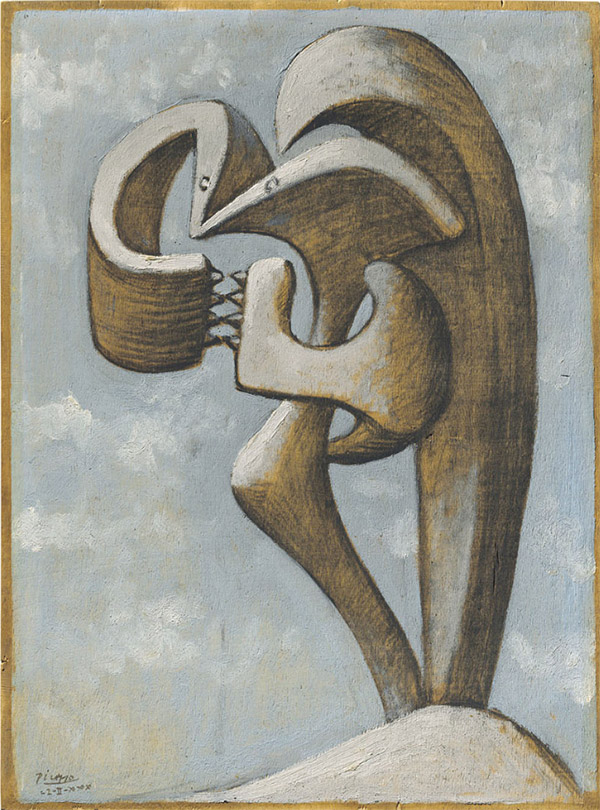Controversies and avant-garde
Lloyd Goodrich of Arts pointed out that he had heard the recent pictures referred to as the “extractions of Picasso.” He described them as “extraordinary visions of grotesque shapes reminiscent of a bone-yard, with suggestions of pelvic bones, ribs, collar-bones, teeth … they have enough features suggestive of human anatomy to be intriguing in a Freudian kind of way, and even a little horrifying.”[i] An unnamed writer for Art Digest noted, “Even the Bolshevik New York art critics could not digest the show without some effort.”[ii] In the Brooklyn Daily Eagle, the reviewer observed:
[the show’s] emphasis on the 1930 abstractions, that baffling semisurrealist phase which even some of the most ardent Picasso admirers admit is a little beyond them. It is quite that to the writer… Were not the magical name of Picasso attached to these canvases (sic) … were there not just a suspicion of being afraid that a new and baffling phase would find them lacking in the requisite sensibility, it is doubtful if these recent canvases would call forth the lusty eulogies overheard on the opening day.[iii]
The New York Evening Post published Dudensing’s response to the press: “[Dudensing] declared with minatory gesture that he is going to preserve all the critics’ comments on this particular phase of Picasso’s work and in ten years’ time produce them and confound the recalcitrant ones.”[iv]
Art News addressed the controversy surrounding the exhibition in an editorial titled “Abstract Art in America”:
The current Picasso exhibition of abstractions, with their challenging variations of form, is quite liable to be a turning-point in American painting. The Valentine Gallery, the art students’ favorite stamping (sic) ground, will doubtless become something of a battlefield on which the issues of this rapidly advancing art form will be fought out during the next weeks. At each fresh demonstration of abstractions in America, the opposing factions become more sharply divided. Those who welcome this release from stereotyped forms of painting grow louder in their praise. Those who still prefer the quiet reaches of naturalistic, representational art wax more irate. That there is a definite issue at stake becomes increasingly clear.... All signs point to the fact that abstract art is here to stay.[v]
Despite the controversy, or perhaps because of it, Dudensing sold seven Picasso paintings that month. Mrs. Richard Dudensing, the wife of his cousin, bought an unidentified work.[vi] James Thrall Soby, an author and critic, bought a 1920s Mother and Child, a small (unidentified) work from the gallery’s inventory that was not part of the exhibition.[vii] One of the gallery’s biggest clients, Stephen C. Clark, acquired three paintings including one from the exhibition, the 1924 Guitare et compotier sur un gueridon (Z.V,268), while Sidney Janowitz (later Janis) purchased an unidentified painting.[viii] Gallatin bought Nature morte: guitare et compotier (La mandoline), 1922 (Z.V,91) from the exhibition; the press announced this latest acquisition by the Gallery of Living Art. [ix]
[i] “Exhibitions: Picasso’s Latest,” 17, 6 (March 1931), 413-4.
[ii] “The Art Season” 5, 8 (January 15, 1931), 15.
[iii] “Abstractions by Pablo Picasso,” (January 11, 1931), 15B
[iv] Margaret Breuning, “Picasso Abstractions,” (January 10, 1931), 6D.
[v] Art News, 29,15 (January 10, 1931), 14.
[vi] The Valentine Gallery’s sales records lack critical information such as title, date, medium, and size making identification of the works extremely challenging. The prices, therefore, are an important clue in determining if a work is on canvas or paper. In 1931, Mrs. Richard Dudensing may have purchased Cabines de bain, Dinard, 1929, which she loaned to the 1936 retrospective at the Valentine Gallery. Valentine Dudensing Ledger Book, vol. II, January 1926-February 1931, p. 133. The Museum of Modern Art Archives, New York.
[vii] Valentine Dudensing Ledger Books, vol. 3: 1930-1939, p. 150. The Museum of Modern Art Archives, New York. Mother and Child is listed as the Picasso painting Soby purchased on January 12, 1931. “Account with the Valentine Gallery, Inc.” James Thrall Soby Papers, V.D.1. The Museum of Modern Art Archives, New York.
[viii] Valentine Dudensing Ledger Books, vol. II: January 1926-February 1931, p. 133 and vol. III, 1930-1939, p. 150. The Museum of Modern Art Archives, New York.
[ix] Valentine Dudensing Ledger Books, vol. 3: 1930-1939, p. 150. The Museum of Modern Art Archives, New York. “Two Unequivocal Abstractions,” New York Times (February 15, 1931), 12X, illus; and “Gallery Notes,” The Art News (February 14, 1931), 14.





 índice
índice